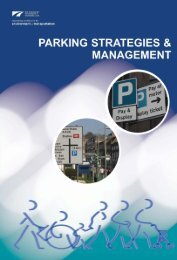Level 2 and 3 Diploma in Business Support (4475-12/13)
Level 2 and 3 Diploma in Business Support (4475-12/13)
Level 2 and 3 Diploma in Business Support (4475-12/13)
Create successful ePaper yourself
Turn your PDF publications into a flip-book with our unique Google optimized e-Paper software.
4 A SWOT analysis considers the strengths, weaknesses, opportunities <strong>and</strong> threats of an<br />
organisation.<br />
A SWOT analysis groups key pieces of <strong>in</strong>formation <strong>in</strong>to two ma<strong>in</strong> categories:<br />
• Internal factors – The strengths <strong>and</strong> weaknesses <strong>in</strong>ternal to the organisation<br />
• External factors – The opportunities <strong>and</strong> threats presented by the external environment to<br />
the organisation.<br />
Through the use of a SWOT analysis the key <strong>in</strong>ternal <strong>and</strong> external factors that are important to<br />
achiev<strong>in</strong>g an objective can therefore be identified The f<strong>in</strong>al outcome of the SWOT analysis allows<br />
an organisation to assess whether or not it is successful, whether a project can work or an<br />
objective be met <strong>and</strong> where changes should be made. An organisation can use the SWOT to<br />
cont<strong>in</strong>ually assess its success (or otherwise) <strong>and</strong> decide what is work<strong>in</strong>g <strong>and</strong> what isn’t, what is<br />
affect<strong>in</strong>g them as an organisation <strong>and</strong> what the threats are <strong>and</strong> make improvements/ changes as<br />
required <strong>and</strong> then evaluate whether these have worked.<br />
5 An organisation should be able to analyse the impact of any change through customer feedback<br />
obta<strong>in</strong>ed from different sources, eg observation, questionnaires, reduction <strong>in</strong> compla<strong>in</strong>ts etc.<br />
Any change should be monitored <strong>and</strong> reviewed. Any monitor<strong>in</strong>g or review must consider the<br />
impact the change has had on customers, employees, the organisation <strong>and</strong> further<br />
improvements may be needed before a change can be deemed successful.<br />
Outcome 2 Be able to describe the process of promot<strong>in</strong>g products <strong>and</strong><br />
services<br />
1 A unique sell<strong>in</strong>g po<strong>in</strong>t or proposition (USP) def<strong>in</strong>es an organisation’s competitive advantage. An<br />
organisation must identify what makes it different from the competitors <strong>and</strong> emphasise these<br />
advantages <strong>in</strong> market<strong>in</strong>g thus <strong>in</strong>fluenc<strong>in</strong>g the customer’s choice of products <strong>and</strong> services.<br />
2 A USO (Unique Service Offer) is used to differentiate a service offer from that of competitors or<br />
comparable organisations. USOs are directly related to why customers choose to do bus<strong>in</strong>ess<br />
with organisations.<br />
3 Many methods of promotion are available to organisations eg advertis<strong>in</strong>g, word of mouth, pr<strong>in</strong>t<br />
media such as local <strong>and</strong> national papers, telesales, TV, radio <strong>and</strong> other advertis<strong>in</strong>g campaigns.<br />
Organisations will also use techniques such as sell<strong>in</strong>g benefits NOT features to promote their<br />
product/ services to customers.<br />
4 Cost-benefit analysis is a term that refers to the process <strong>in</strong>volved <strong>in</strong> weigh<strong>in</strong>g the total expected<br />
costs aga<strong>in</strong>st the total expected benefits of one or more actions <strong>in</strong> order to choose the best or<br />
most profitable option.<br />
This means that the cost of any promotion method will be weighed aga<strong>in</strong>st the likely benefits<br />
before a decision is made on the best or most cost effective one.<br />
5 It is important to evaluate promotions to assess the impact of a promotional campaign on an<br />
organisation’s ability to <strong>in</strong>crease market share <strong>and</strong>/or customer satisfaction <strong>and</strong> to ensure there<br />
has been value for money.<br />
Outcome 3 Be able to expla<strong>in</strong> the importance of effective teamwork <strong>and</strong><br />
the monitor<strong>in</strong>g of performance<br />
1 When manag<strong>in</strong>g a team use of the correct method of communication is vital.<br />
There are a number of ways <strong>in</strong> which a team can be communicated with eg:<br />
• Team brief<strong>in</strong>g – a team brief<strong>in</strong>g allows management to <strong>in</strong>form staff on subjects that are<br />
important, give an explanation on a regular basis.<br />
• One to one communication which allows the two parties to ask questions <strong>and</strong> ensure<br />
underst<strong>and</strong><strong>in</strong>g. Good face to face communication allows immediate feedback on what the<br />
<strong>Level</strong> 2 <strong>and</strong> 3 <strong>Diploma</strong> <strong>in</strong> Bus<strong>in</strong>ess <strong>Support</strong> (<strong>4475</strong>-<strong>12</strong>/<strong>13</strong>) 193







